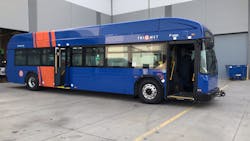TriMet expands electric bus testing with longer range bus option
TriMet took delivery of the first of five new electric buses from GILLIG during the weekend of March 20, 2021. The bus, which can travel 150 to 210 miles on a single charge, will undergo testing for at least 60 days before entering service on a 26.5-mile, 265-stop route. TriMet estimates it will take delivery of the final four GILLIG buses this summer.
TriMet explains the bus is expanding its evaluation of battery-electric technology with a long-range option. In April 2019, TriMet took delivery of its first of five New Flyer Xcelsior CHARGE™ buses and has two 60-foot articulated buses from New Flyer on loan as it tests solutions for a transition to an all-alternative fuel bus fleet by 2040.
“TriMet’s commitment to making our community a better place includes our transition to a 100 percent clean energy bus fleet,” said TriMet Interim General Manager Sam Desue, Jr. “This is how we give back and continue transit’s contribution to reducing carbon emissions and improving the environment, especially in areas disproportionately impacted by poor air quality.”
The cost of the five GILLIG buses, training, warranties and charging equipment totaled more than $5.5 million, which was covered in part with a $2.29-million grant through the Federal Transit Administration’s Low or No Emission Grant Program.
“We are delighted to provide TriMet with our latest electric bus technology,” said GILLIG Vice President of Sales Bill Fay. “TriMet’s dedication to zero-emission public transit means cleaner air and less traffic for the cities they serve.”
The agency previously partnered with Portland General Electric to build and maintain 12 electric charging stations at its Merlo Operations Facility in Beaverton, which is where the GILLIG electric buses will be based and charged each night. However, the GILLIG electric buses will transfer their base of operations to TriMet’s Powell Operations Facility in 2022 following completion of a remodeling project at the garage.
TriMet explains the buses dispatched out of the Powell facility serve communities of East Portland and Multnomah County. Nearly a quarter of the residents in outer East Portland live at or below the federal poverty level.
“We recognize that low-income communities and communities of color in the Portland metro region are disproportionately affected by carbon emissions. As we roll out our clean energy plan, we are intentionally focusing green technologies in areas that have been impacted by diesel and other pollutants,” said TriMet.
About the Author

Mischa Wanek-Libman
Group Editorial Director
Mischa Wanek-Libman is director of communications with Transdev North America. She has more than 20 years of experience working in the transportation industry covering construction projects, engineering challenges, transit and rail operations and best practices.
Wanek-Libman has held top editorial positions at freight rail and public transportation business-to-business publications including as editor-in-chief and editorial director of Mass Transit from 2018-2024. She has been recognized for editorial excellence through her individual work, as well as for collaborative content.
She is an active member of the American Public Transportation Association's Marketing and Communications Committee and served 14 years as a Board Observer on the National Railroad Construction and Maintenance Association (NRC) Board of Directors.
She is a graduate of Drake University in Des Moines, Iowa, where she earned a Bachelor of Arts degree in Journalism and Mass Communication.
